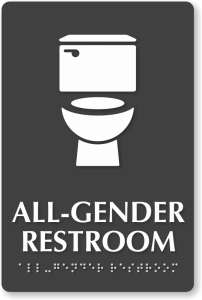New York City to require all-gender bathrooms
 A proposed bill in New York City would require businesses with single-occupancy bathrooms to replace existing, gender-focused signs with signs that designate all-gender bathrooms.
A proposed bill in New York City would require businesses with single-occupancy bathrooms to replace existing, gender-focused signs with signs that designate all-gender bathrooms.
Why does this matter? For everyone’s sake, the new legislation would mean that you no longer have to wait in an endless line for the bathroom intended for your identified gender when the other bathroom is wide open. (We’ve all been there.)
For transgender people in particular, however, the issue is about much more than convenience. Gender-neutral bathrooms can be a matter of personal safety. They can even be a matter of life and death.
Transgender people routinely face harassment and violence when attempting to use bathrooms associated with their gender. In fact, there is even an app called Refuge Restrooms that helps identify public all-gender bathrooms that are safe for trans people to use.
The bill wouldn’t apply to multi-stall bathrooms, and it doesn’t require any rebuilding or restructuring. All it means, quite literally, is purchasing and putting up a new sign.
“Just putting a sign on an existing bathroom will go a long way to reducing discrimination,” said New York City Comptroller Scott Stringer, whose office supports the proposed legislation. Stringer describes the bill as “a very important issue.”
Not everyone is on board with gender-neutral bathrooms and the move toward equality that this change represents. Ann Friedman of New York Magazine writes that a group in California is “collecting signatures to try to get an initiative on the ballot that, according to Equality California, ‘would prohibit transgender people from using facilities in government buildings and require the government to monitor bathroom use.’”
Why are there even separate bathrooms to begin with? It’s an old rule, and it stems from the Victorian era. Back then, women weren’t “supposed” to be active participants in public life. Many public institutions only had bathrooms for men, which made those institutions unofficially very unwelcome to women. It sent a clear message: stay home.
As women started to join in on public life, those in power felt the need to “protect” women by giving them separate bathrooms. The Uniform Building Code and International Building Codes included a clause requiring buildings to provide separate bathrooms for men and women. This was intended to make sure women had equal access.
Even though the male-only public institutions that necessitated the original rules are all but obsolete, many buildings are still modeled on those antiquated codes.
The newly proposed legislation sends an updated message: Come as you are. You’ll be able to do your business in peace.
A simple sign swap speaks volumes to people who have to worry about personal safety when attending to life’s most basic needs.










